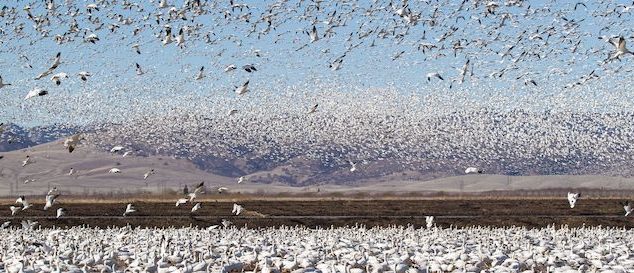Opinion
A joint effort to protect the Central Valley’s water, ecology
 Thousands of geese gather in the rice-growing lands of the Sacramento Valley.(Photo: Jm Morris)
Thousands of geese gather in the rice-growing lands of the Sacramento Valley.(Photo: Jm Morris)Like a human fingerprint, California’s Sacramento Valley is truly unique. On the leading edge of ecological and economical sustainability, it’s also an exceptional place to live, work, and raise a family.
The Sacramento Valley joins together a world-renowned mosaic of natural and human abundance: productive farmlands, teeming wildlife refuges and managed wetlands, the largest salmon runs south of the Columbia River, dynamic rural and urban communities, and life-giving rivers and creeks that support it all.
A new collaborative way forward has emerged that makes space for farms, fowl, and fish to all thrive without choosing between one or another.
Yet we are missing the full suite of benefits once provided by the interaction of the Sacramento River with the Valley’s formerly vast floodplain wetlands.
However, science-based reactivation of floodplains can provide critical benefits for fish, birds, and people. By reconnecting rivers to streamside wetlands on working ricelands and in natural habitats, we can restore the Sacramento Valley’s natural engines of ecological productivity. A working river-wetland ecosystem in the Sacramento Valley will result in more abundant and healthy populations of fish, birds and wildlife.
To put forward our shared vision of creating an ecologically functioning Sacramento Valley ecosystem — capable of supporting human communities and economies as well as abundant fish and wildlife populations — the California Rice Commission (CRC), California Trout (CalTrout), Ducks Unlimited (DU), and the Northern California Water Association (NCWA) have entered into a Memorandum of Understanding (MOU).
Together we will work to preserve, sustain, and promote the Sacramento Valley’s working and natural landscapes to create a healthy, vibrant future for both people and the environment. Together we will enhance the health of floodplain and river ecosystems to renew the bountiful interactions of sun, water, and land.
This holistic water management strategy moves the Sacramento Valley towards its natural potential.
Amidst the Sacramento Valley’s busy landscape, a new collaborative way forward has emerged that makes space for farms, fowl, and fish to all thrive without choosing between one or another.
The old ways separated species from their environment. These new ways integrate a 21st-century ecological understanding of fish, wildlife, and natural processes into the design and operation of the Sacramento Valley’s rivers and floodplains. This new way forward incentivizes both public agencies and private landowners to collaboratively create solutions that benefit fins, feathers, farms, and families.
Already, this “Sacramento Valley model” has generated success, particularly along Butte Creek, where modernizing water diversions, removing small dams, and reactivating the floodplain has demonstrated how waterfowl, farming, and spring-run Chinook salmon can all thrive on the same landscape. This holistic water management strategy moves the Sacramento Valley towards its natural potential.
With an ecosystem perspective, the Valley’s floodplains can grow crops for people in the spring, create habitat for birds and other wildlife in the summer and fall, and support the migrations and appetites of both fish and birds during winter.
Our coalition has used this collaborative, science-based approach to compile a portfolio of Sacramento Valley projects that provide for the habitat needs of salmon and migratory birds at each life stage where they depend on Sacramento Valley lands and waters.
Working with federal, state, and local governments as well as diverse private stakeholders, we will strive to implement this landscape-scale investment in nature-based solutions to spawn an ecological, functioning Sacramento Valley ecosystem, from ridgetop to river mouth.
With our partnership, we are forging a new way forward to reactivate our floodplains and modernize our water and flood infrastructure, making the aquatic ecosystem — as well as California’s agricultural and urban water supply — more resilient to the major climate threats facing our State: extreme floods and more severe droughts.
—
Editor’s Note: Curtis Knight is the executive director of Cal Trout, Jeff McCreary is director of operations for Ducks Unlimited Western Region; Tim Johnson is president and CEO of the California Rice Commission and David Guy is the president of the Northern California Water Association.
Want to see more stories like this? Sign up for The Roundup, the free daily newsletter about California politics from the editors of Capitol Weekly. Stay up to date on the news you need to know.
Sign up below, then look for a confirmation email in your inbox.

Leave a Reply